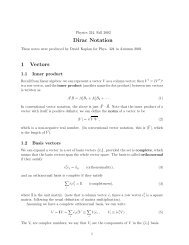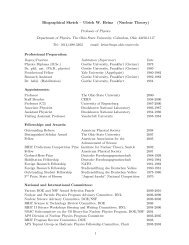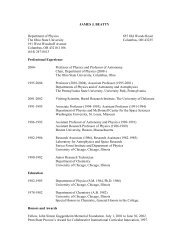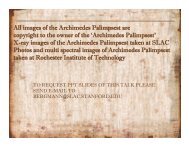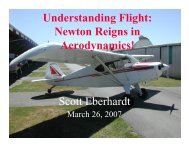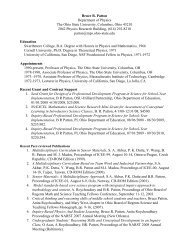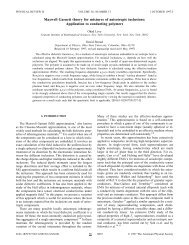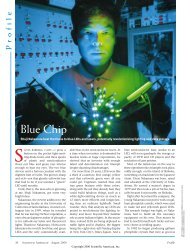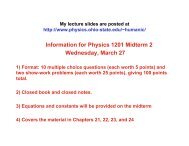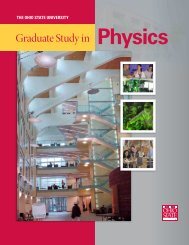Brasil Final Report - Department of Physics - The Ohio State University
Brasil Final Report - Department of Physics - The Ohio State University
Brasil Final Report - Department of Physics - The Ohio State University
Create successful ePaper yourself
Turn your PDF publications into a flip-book with our unique Google optimized e-Paper software.
42<br />
Another program, ProInfo, begun in 1997, built upon previous initiatives in teacher training<br />
by running state-administered, lato sensu courses as joint ventures with the universities. This<br />
program, still in existence today, aims to make IT universally available in state schools. Some <strong>of</strong> the<br />
goals set in 1997 and 1998 were to have 100,000 computers in schools, 200 Centers <strong>of</strong> Educational<br />
Technology and to provide training for 25,000 teachers.<br />
Despite the efforts <strong>of</strong> the ProInfo Program and the funds invested, the use <strong>of</strong> new<br />
technologies is still mainly restricted to the use <strong>of</strong> computers and videos in education, because<br />
students’ access to the Internet is still very limited. A description <strong>of</strong> the current situation regarding<br />
the use <strong>of</strong> new technologies in schools would be that there are IT laboratories, chiefly in the<br />
independent schools; computer use is related neither to the curriculum nor to the teacher’s work; the<br />
computer is used mainly for computer-literacy and learning reinforcement.<br />
Educational Use <strong>of</strong> New Technologies<br />
One <strong>of</strong> the factors that influence the use <strong>of</strong> new technologies in education is the contribution<br />
<strong>of</strong> research to new theories concerning human cognition. An important milestone was reached with<br />
the migration from a behaviourist to a constructivist paradigm. Constructivism applied to<br />
instructional design changed the role <strong>of</strong> the computer in education: the computer was no longer “a<br />
tutor”, as it had been under the behaviourist paradigm. Educational approaches derived from<br />
Constructivism, as exemplified by Cognitive Flexibility <strong>The</strong>ory (Spiro et al, 1992) and Situated<br />
Cognition (Brown et al., 1989) are also employed to guide the development <strong>of</strong> constructivist<br />
learning environments and hypermedia systems. A common aspect among these frameworks is the<br />
use <strong>of</strong> technology to simulate reality.<br />
Constructivist learning environments challenge students to collaborate in seeking solutions to<br />
real-life problems (Brown et al., 1989, Wilson, 1996). <strong>The</strong>se environments can provide realistic<br />
simulations using videodiscs or virtual reality in which students have to solve scientific problems as<br />
if they really were scientists. Students engage in the problem, gather data, formulate hypotheses for<br />
its solution and come to decisions and make judgements.<br />
<strong>The</strong> design <strong>of</strong> hypermedia systems can be well-suited to the kinds <strong>of</strong> “landscape crisscrossing”<br />
as recommended by Cognitive Flexibility <strong>The</strong>ory and needed in ill-structured domains, as<br />
they can provide rearranged instructional sequences, multiple dimensions <strong>of</strong> knowledge<br />
representation and multiple interconnections across knowledge components, as provided by the<br />
following elements (Jacobson, 1994):<br />
(i) Cases and rich examples;<br />
(ii) Multiple forms <strong>of</strong> knowledge representation;<br />
(iii) Link abstract concepts to case examples;<br />
(iv) Demonstrate conceptual and thematic variability in ill-structured domains;<br />
(v) Interrelated and web-like nature <strong>of</strong> knowledge;<br />
(vi) Knowledge assembly from different conceptual/thematic and case resources;<br />
(vii) Promote active learning.<br />
Although all these resources are available, little attention is being paid to the educational use <strong>of</strong> new<br />
technologies (including video) either by physics education researchers or by physics teachers in this<br />
subject, a fact reflected in the low number <strong>of</strong> papers being presented at recent Brazilian conferences<br />
on physics or science education (Table 1).




